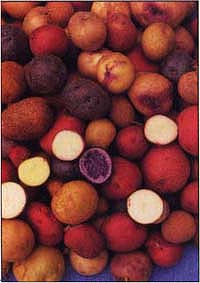All Issues
Science Briefs
Publication Information
California Agriculture 49(2):4-4.
Published March 01, 1995
PDF | Citation | Permissions
Full text
Trapping tomato stinkbugs
UC Davis and USDA scientists have developed a new insect-trapping system that will help growers track migration of consperse stinkbugs, insects that annually damage thousands of dollars worth of California's tomato crops.
The researchers spent nearly 8 years designing and developing the trap, which relies on “pheromones” or chemical attractants, says project leader Frank Zalom, director of the Statewide Integrated Pest Management Project. “Unlike many ‘sex’ pheromones that attract only males, this is an aggregation pheromone and attracts both sexes and immatures.” By placing two or three traps in a field, growers can monitor stinkbug populations to determine when to begin more intensive field sampling. These measures can help growers implement control measures that use pesticides more effectively.
Zalom says the new pheromone traps may be commercially available later this year.
Polka dot potatoes?
There are hundreds of potato varieties producing tubers in many different colors, shapes and sizes. The large, oblong All Blue potato has purple skin, purple flesh and a white ring or white steaks near the skin. A good boiling potato, the All Blue's flavor and texture are similar to conventional white potatoes.
Ron Voss, a UC Davis vegetable crops specialist, believes specialty potatoes could be a new crop and niche market for many California farmers. Production techniques for specialty varieties are nearly the same as for traditional potatoes, he says. The differences are in marketing and varieties.
The round Yellow Finn potato has yellow flesh, buff skin and a more nutty flavor. The long, slender Banana potato, with its dry texture and strong flavor, is excellent for baking. Another fingerling variety, the Ruby Crescent, has an almost waxy texture.
Wild potatoes in South America are even more diverse, including some with polka dotted skin. A white-with-purple splotched potato bred at UC Davis tastes like a common potato, but its unusual look may appeal to gourmet cooks, Voss says. Orange flesh and red flesh potatoes are also being developed.
Bats and barn owls patrol orchards
Growers battling pocket gophers may have a new ally, the barn owl. Fresno County farm advisor Mark Freeman is developing methods to attract native barn owls into orchards and working with other agencies to release “orphaned” owls into agricultural areas.
In 1994 Freeman focused on developing a system of releasing barn owls raised in captivity. He has been using owls that were found as immature birds, turned in to Fresno Wildlife Rehabilitation and hand-raised by trained volunteers. With help from growers, Freeman designed a release cage large enough to allow the owls to adjust to new surroundings. California Fish and Game has approved this design.
Owl boxes are used to entice released owls to stay in the area and attract native barn owls. Owls prefer to nest in enclosures 12 feet or higher off the ground. To remedy the lack of adequate sites, PG&E is allowing Freeman to place owl boxes on specific power poles that have insulated wiring.
Last year, 75 birds were released at 15 locations in Fresno and Madera counties. “This year more owls will be released and we'll try to document their feeding habits and acceptance of nesting boxes,” Freeman says. “After feeding, the birds leave pellets that contain the bones and skulls of the prey. We hope to develop go-pher monitoring methods and use advanced techniques such as radio telemetry for tracking owls to determine how effectively they will control gophers.” The owls may not eliminate the need for traditional gopher control methods such as poison baits, traps and flooding, but he believes they will help.
Bats are another winged predator that growers may employ to suppress pests. Bats feed on moths, mosquitoes and rootworms. A bat can eat its weight in insects in a night. Contrary to popular misconceptions, bats are not blind, do not become entangled in human hair, seldom transmit disease to humans and other animals and generally produce only one young per year.
Solano and Yolo counties farm advisor Rachael Freeman Long is studying bats to find out which insects they are eating. With funding from the California Pear Advisory Board, she will attempt to inventory the number and species of bats in the area, then determine how to attract bat colonies.





